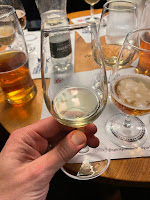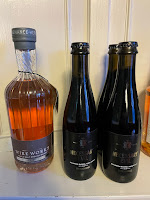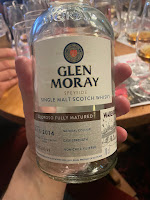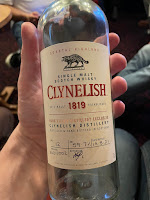 |
| Flagship |
We had a distillery tasting for our November meeting. And not just any old distillery, either, but one of the pioneers of the boom in English whisky, Spirit of Yorkshire.
Based in Hunmanby close to the North Sea coast, it's home of not only Filey Bay whisky but also Wold Top brewery. Brand ambassador Amy explained the local, sustainable ethos of this independently-run business, which grows all its own barley on the farm and controls all aspects of the production process from field to bottle.
 |
| Scarborough Fair IPA |
We've had Filey Bay a few times over the years, not least when its first products came onto the market in 2019 (I bought a bottle of the inaugural release which I foolishly/not foolishly drank, it's now worth a lot more than I paid for it). So it was great to be reacquainted with what is one of our closest distilleries.
We had seven drinks to try, a mixture of whisky and beer. And first up was an example of Filey Bay's core expression, called Flagship. What you can buy now is a 5-year-old at 46%. It's a very easy drinker, light and creamy. Lots of us had tried this at some point before, and it's well-liked: "It's nice".
 |
| Barrel Wave |
Amy said the aim of the drink was not to copy Scotch whisky but to respect it as a marker of what they were trying to achieve, and Flagship does this admirably. There are apples and pear drops there, too.
Our first beer was drink number two, an IPA called Scarborough Fair (Filey being on the way to Scarborough, more or less). At 6% this was very hoppy and was also sweet and fruity, with lots of grapefruit notes. Very refreshing, and ideal for a hot summer's afternoon we felt.
 |
| IPA finish whisky |
Amy was taking us on a journey from whisky to beer to whisky-aged beer and, eventually, beer-aged whisky. So next was another beer, Barrel Wave. It was 9.1% but did not drink like it.
Having spent almost a year in a cask, it tasted like something quite different from its golden appearance, much more like a stout or a porter. Much sweeter all round, in fact almost a bit too sweet some felt. "Great but I wouldn't want it all that often" someone suggested. On that theoretical hot summer's afternoon, this one might be deceptively dangerous to have to hand.
 |
| STR finish batch 4 |
And so onto that IPA finished whisky. There are a few IPA finishes around, and they are not all universally liked (if I can interject a personal opinion I remember not being wildly impressed by the Jamesons Caskmates IPA, having enjoyed the stout version quite a lot). But on trying this we were soon clear this was something rather more special.
A 5-year-old and 46% again, but seemed stronger. Nice and chewy, but retaining that grapefruit from the beer. Very refreshing all round. We loved it! And with a price tag of £65, quite a few of us bought a bottle to take home at half-time.
 |
| Peated finish batch 3 |
After an opportunity to recharge our beer glasses downstairs at the bar of the Britons Protection, it was on to our fifth drink and third whisky.
Amy served up an STR finish, from their fourth batch. STR is a technique pioneered and popularised by the late Jim Swan, who served as an adviser to Spirit of Yorkshire among others. It stands for shaved, toasted and recharged, and, at the risk of oversimplifying massively, acts as a way of rejuvenating red wine barrels to give a subtler flavour suitable for whiskies.
 |
| Sherry cask reserve 5 |
This particular bottle had spent 9-10 months in the STR cask at the end of the maturation period. Lots of red fruits and jam here, it was juicy and moreish. Well worth it again at £65.
We got a taste of peat for drink six, with batch 3 of their peated finish. It had spent the last 11 months in casks which previously held Islay whisky, long enough to give us a proper tease of peat without being too overwhelming. Nutty and creamy, but with a bit of salty brine as well.
Some of the bigger peat monsters in the club wanted a bit more of a hit from it, but having said that, it was still surprising how much peat you got from less than a year in those casks. It did smell a bit more peaty than it actually tasted though, perhaps. Again, £65.
Which brought us onto the last dram of the evening, the end-of-year special release sherry cask reserve 5. A 6-year-old full maturation in PX and ex-moscatel barrels, this was very nice indeed, and one of the oldest expressions so far released under the Filey Bay brand. Lots of justified acclaim in the room for this one, which we thought "wonderful" and "brilliant".
And that brought us to the dram of the night voting (we excluded the beers from this one). And the winner was the STR finish with no fewer than 14 votes, ahead of the IPA and sherry cask reserve which were joint second. But all of the whiskies got at least one vote, again suggesting how strong the tasting was from top to bottom.
Thanks to Amy from Spirit of Yorkshire for taking us through such a great line-up, and also thanks to all club members and guests for attending, and to the Britons Protection for hosting us once again. That was the last formal tasting of the year, with just the Christmas Party remaining. As ever, there will be a much less full report of that one!






















































